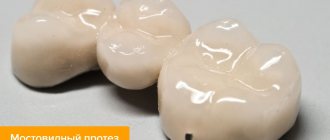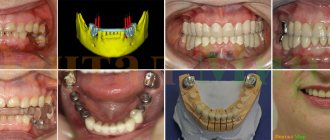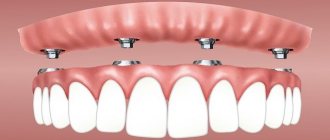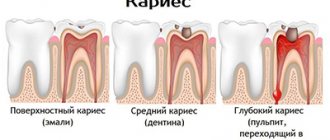Dental bridge - this is what people most often call dental bridges used by dentists to restore teeth when several units in a row are missing in a row. Dental bridges come in many different types, are made from different materials, and each type of structure has its own characteristics and advantages. Naturally, the price of different types of dental bridges will also differ.
In this article, we will tell you in detail about dental bridges: we will describe in detail the indications for their use, consider the types of dental bridges, the main characteristics, and also indicate approximate prices for production and installation in Moscow.
Indications for installation of dental bridges
Dental bridges are used to restore lost teeth, but not with single defects in the dentition, but when two, three or four teeth are missing. Bridges are applicable for the restoration of chewing and anterior dental units and effectively restore both the aesthetics of the dentition and all important functions of the teeth.
IMPORTANT: Installation of a dental bridge requires healthy supporting teeth. If the patient does not have strong teeth or has complete edentia (toothless jaw), the doctor may recommend either a removable denture or implantation followed by prosthetics with a conditionally removable orthopedic design. Implantation can be a good solution if the patient does not want to grind down healthy teeth for a bridge.
What a dental bridge looks like: description of design features
A dental bridge is a fixed prosthesis attached to supporting teeth and used to eliminate multiple edentia (the absence of several teeth in a row). The main elements of a dental bridge are artificial teeth and fasteners, with the help of which the prosthesis will be firmly fixed in the oral cavity.
Attachments for dental bridges can be in the form of:
Dental crowns placed on abutment teeth
Tabs
Clammers
Sometimes the design of a dental bridge also includes an additional element - a part designed to imitate a section of gum. Externally, the prosthesis resembles a bridge – that’s why it got its name.
The intermediate part of the dental bridge may have a different mechanism of connection with the soft tissues of the oral cavity:
- Flushing connection. In this case, a small space remains between the dental bridge and the soft tissues of the mouth, which ensures free passage of food under the denture, and therefore easier care for it;
- Tangent connection. With this type of connection, one side of the bridge will touch the gums, and such prostheses are especially relevant in the restoration of teeth included in the smile zone. They provide better aesthetics, are easy to use, and do not interfere with normal diction;
- Saddle-shaped. With this connection, the bridge connects to the soft tissues of the mouth as tightly as possible.
The type of dental bridge design is selected at the stage of planning prosthetics and together with the doctor leading the treatment!
Work examples:
All works
Bridge prosthetics with metal-ceramic crowns
Manufacturing of metal-ceramic fixed bridge prosthesis
All works
Sign up for a consultation
three ROOTT specialists + diagnostics as a gift
Types of dental bridges
At the very beginning of the material, we mentioned that there are quite a large number of different types of dental bridges. The classification of bridges is carried out both according to the material of manufacture and the production technology.
Based on the first feature, the following types of dental bridges are distinguished:
Metal
Metal-ceramic
Ceramic
Zirconium
Plastic
Based on production technology, the following dental bridges are distinguished:
- Adhesive. It is most often used when only one tooth needs to be restored with a bridge. Such a prosthesis has a base - a fiberglass arch on which the artificial tooth is located;
- Stamped dental bridges are several dental crowns welded into a single structure;
- Cast dental bridges are the most durable denture option.
The material and manufacturing technology of a dental bridge will determine its cost and also its main performance characteristics, and below we will look at the main types of bridges, their features, pros and cons.
But first, let’s answer a question that patients often ask orthodontists – which is better, a dental bridge or implants?
Method No. 2: using ultrasound
Are you wondering how to remove a crown from permanent cement in one of the safest and most innovative ways, and without causing any damage to it? Then ask your dentist if it is possible to use ultrasound in your case. Through impulses, the doctor acts on the cement composition, which gradually cracks. The specialist moves along the “tooth-crown” boundary; under the influence of vibrations, the cement is destroyed.
The product can be removed using ultrasound
The procedure really allows you to remove the structure in its original form, but it has a number of disadvantages. First, ultrasound has a rather gentle effect, so it is not always possible to achieve the goal the first time, and sometimes you have to visit the doctor several times. Secondly, only products that are made from not very dense materials are amenable to hardware exposure to sound waves. For example, it will not be possible to remove structures made using glass ionomers using ultrasound. Third, vibrations may be unpleasant for the patient.
Which is better - a dental bridge or an implant?
Here we need to make an important note - prosthetics can be carried out without implants, but implantation necessarily involves the stage of prosthetics. Of course, implantation of implants will increase the final cost of treatment, however, when installing a prosthesis on implants, you will not have to grind down healthy teeth, in addition, the dental bridge will be fixed as firmly as possible in the oral cavity and this increases the comfort of its use, as well as the useful life of the prosthesis.
But of course, the patient and the doctor must decide how to restore teeth in a specific clinical case. For example, if examination and diagnostics reveal absolute contraindications to implantation, then lost teeth will have to be restored using classic prosthetics and the installation of a dental bridge on the supporting teeth.
How much does dismantling cost?
The price for the service of removing an orthopedic device consists of the material from which it is made, the number of crowns to be removed and the method chosen by the doctor to remove it. How much does it cost to remove a fixed prosthesis? On average, the cost ranges from 800 to 3,000 rubles. And, as a rule, it is included in the total amount for subsequent treatment and preparation for prosthetics, or more precisely, re-prosthetics.
Metal dental bridges: pros, cons
Metal dental bridges can be called an outdated type of bridge prosthesis - they are almost never used in modern dental prosthetics, because the number of their disadvantages significantly outweighs the number of advantages. Dental bridges made of metals and their alloys are too heavy and bulky; their installation causes increased wear and tear on healthy teeth.
In addition, metal dental bridges are not highly aesthetic; when wearing them, a person may constantly feel an unpleasant and pronounced metallic taste in the mouth. The risk of an allergic reaction cannot be excluded. If we talk about the advantages of metal bridges, there are only two of them - maximum strength and low price. Of all types of metal dental bridges, solid dentures will have the highest reliability and durability.
Thanks to casting production technology, such dental bridges have a long service life and are able to flawlessly withstand constant and heavy loads. Dental bridges of this type are recommended for installation in patients with deformation of facial features caused by atrophy of the jaw bone tissue.
Metal dental bridges can be made from different metals and their alloys, including precious metals. Typically, the raw material for the production of metal dental bridges is cobalt-chrome alloy. But gold can also be used. Then the price of the prosthesis will increase, but neither its aesthetics nor the degree of comfort in use will improve. If prosthetics are carried out in the area of the front teeth, then dental bridges made of metal ceramics and ceramics can be a much more successful solution; if you need to restore chewing teeth, you can opt for the strongest bridges made of zirconium.
How much does a metal dental bridge cost? The answer to this question will depend on the technology of its production, as well as on the number of crowns in the structure, and the type of metal used to make the prosthesis. For example, if ordinary metal is used and a bridge is made for two dental units using casting technology, the cost of the prosthesis will range from 8 to 9 thousand rubles.
How is production carried out?
According to the manufacturing method, frames are of the following types:
- cast: created by casting,
- milled: manufactured using robotic CAD/CAM systems.
Most often, bases made of noble or base metals are created with a thickness of 0.5-0.3 mm. Thinner ones can be coated with a thicker layer of ceramic for better aesthetics. But before making a prosthesis, the patient first undergoes preparation, during which the supporting teeth are depulped and filled. Additionally, they can be strengthened with a pin or stump insert. This way the supports will be more stable under load and will last longer (provided that everything is done correctly). Then impressions are taken from the dentition.
Next, the impressions are sent to a dental laboratory, where a dental technician creates a model of the prosthesis1. A metal base is cast or milled using this model. After which it is covered with several layers of ceramics and then baked at high temperature. The result is a finished product that can be immediately installed on the patient. How long does it take to make a metal-ceramic bridge? Here, a lot depends on the quality of the impressions taken and the workload of the laboratory, but on average you will have to wait 1-2 weeks, and in the meantime you will have to wear a temporary prosthesis (it takes 1 day).
Plastic dental bridges
The main advantage of a plastic dental bridge is its low price. It seems attractive to many people who want to restore lost teeth. However, before making a choice in favor of a budget dental bridge made of plastic, it is worth considering its disadvantages. And there are quite a lot of them. Among the disadvantages of plastic bridges:
- Low aesthetics. Artificial teeth made of plastic do not have the same beautiful natural shine as natural human teeth;
- Fragility. Dental bridges made of plastic easily break and are damaged by stress, but they cannot be restored - the broken element will have to be replaced, which implies new costs for prosthetics;
- Risks of allergic reactions;
- Over time, a plastic bridge will lose its visual appeal, since the plastic can darken under the influence of various factors. In addition, plastic wears out quite quickly. On average, plastic dentures will have to be replaced every 3-5 years.
Due to the listed disadvantages of plastic bridges, it is better to initially plan more expensive prosthetics using dental bridges made of metal-ceramics, ceramics and zirconium.
Is it possible to carry out professional hygiene with crowns?
Both teeth and any dentures require high-quality hygiene. Once or twice a year, have your teeth cleaned with an ultrasound. But Air Flow is prohibited in the presence of multiple crowns, since the drug contains abrasive particles that can damage the smooth surface of the dentures. In such a situation, you should definitely warn the doctor about the presence of crowns or bridges - if there are few of them, you can simply bypass them and carry out Air Flow cleaning in another area.
Metal-ceramic dental bridges: optimal price-quality ratio
Metal-ceramic dentures are quite in demand among patients and this is not surprising, because they are not inferior in strength to metal dental bridges, but at the same time have a much more aesthetic appearance. A metal-ceramic bridge achieves high aesthetics due to the fact that its crowns are covered with a layer of ceramic mass. Layer-by-layer application of ceramics onto a metal base allows you to obtain artificial teeth with the same shade as healthy teeth.
IMPORTANT: Despite the good aesthetics, dentists do not recommend choosing metal-ceramic dental bridges for dental prosthetics in the smile area. The fact is that the metal base of such a prosthesis can be quite noticeably visible through the ceramics. To restore the front teeth, it is best to use metal-free dental bridges that have the most natural and aesthetic appearance.
A metal-ceramic dental bridge can be placed both on abutment teeth and on implants. The price of the bridge will depend on the manufacturing technology and the number of units being restored. The average cost of a metal-ceramic bridge for two dental units is 16,000 rubles.
Unfortunately, it is not always possible to place a metal-ceramic dental bridge on a patient. Bridges made from this material cannot be used if:
- Advanced periodontal diseases;
- For some malocclusion pathologies. If malocclusion is detected, orthodontic treatment is required before installing a metal-ceramic dental bridge;
- Low natural crown of teeth.
Contraindications to the installation of metal-ceramic bridges are identified at the first stage of prosthetics, during which the patient undergoes examination and diagnosis.
Is it possible to smoke if you have dentures?
There is no direct ban on smoking, but you need to understand that nicotine leads to the formation of a large amount of plaque - both on real and artificial teeth. It is difficult to remove; the gums also suffer because of it - they do not receive enough nutrients, atrophy and expose the tooth roots. If you can’t quit smoking, then try to at least reduce the number of cigarettes you consume to a minimum, at the same time improve hygiene at home, and also visit a doctor every 2-3 months for comprehensive oral hygiene.
Ceramic dental bridges
Ceramic dental bridges are the best choice if you need to restore the front teeth that fall into the smile area. Dental ceramics is a material that has transparency and light transmission similar to natural tooth enamel, so dentures made from it have the most natural appearance; they are very difficult to distinguish from natural teeth. However, in terms of strength, ceramic bridges will, of course, be inferior to prostheses made of metal and metal-ceramics. The price for a ceramic bridge of 2 units is from 20 thousand rubles.
If, as a result of prosthetics, you want to get both high strength and aesthetics from the prosthesis, then it is worth considering the option of installing a dental bridge made of zirconium dioxide. This material has been used in dentistry relatively recently, and few patients have heard of it. Dental bridges made from high-quality zirconium dioxide are as attractive as ceramic products, and as reliable as metal structures. Moreover, zirconium is such a durable material that it can be used to make a bridge up to 6 dental units long! Another advantage of zirconium dental bridges is their durability - such a prosthesis can serve you flawlessly for 15-20 years! A zirconium bridge will cost more than a ceramic one - about 30,000 rubles per structure to restore 2 teeth.
IMPORTANT: The price of bridges will be influenced by production technology. The most modern technology for manufacturing dental bridges is CAD/CAM, which involves computer modeling of the prosthesis and its subsequent production using special milling equipment. The technology makes it possible to do without human intervention and, therefore, to avoid inaccuracies and errors. The finished prosthesis has high anatomical accuracy, which increases both the comfort of its use and the useful life of the dental bridge.
Is it possible to cure a tooth without removing the crown?
The question is very relevant, because usually, after removing a structure, it can rarely be reused for its intended purpose, therefore, you have to pay money for the manufacture and installation of a new prosthesis. Fortunately, today in some cases you can do without removing the structure. For example, if it is necessary to cure recurrent caries or remove a small cyst, the doctor may perform endodontic manipulations through a small hole made in the crown or through an incision in the gum (to remove the cyst). After the procedures, this hole will be masked with a composite material, and the sutured gum will need time to heal.
In some cases, modern technologies make it possible to cure a tooth without removing the crown.
However, you need to understand that in order to safely and effectively carry out such jewelry manipulations, the doctor must be a professional. In addition, the patient himself should seek help when the problem is still minor and the inflammatory process has not gone too far. To do this, it is necessary to undergo preventive examinations, because the more minor the problem, the easier it is to solve it with therapeutic methods, without resorting to drastic measures.
Notice
: Undefined variable: post_id in
/home/c/ch75405/public_html/wp-content/themes/UltraSmile/single-item.php
on line
45 Notice
: Undefined variable: full in
/home/c/ch75405/public_html/wp-content /themes/UltraSmile/single-item.php
on line
46
Rate this article:
( 6 ratings, average: 5.00 out of 5)
crown
- Lutskaya I.K., Zinovenko O.G. Frequency of development of caries in teeth covered with artificial crowns.
Adhesive dental bridges: what are they and when are they used?
Adhesive dental bridges can be attached to abutment teeth without first grinding them down. For this purpose, special beams, fiberglass tape or wing-shaped fasteners are used. Adhesive dental bridges are used exclusively for the restoration of anterior teeth, but they are not used to restore chewing units, because such prostheses do not have the required degree of strength.
The advantages of adhesive dental bridges include the following qualities:
- They allow you to carry out the restoration process as quickly as possible;
- They do not require depulping or preliminary grinding of healthy teeth;
- Such bridges have good aesthetics;
- An adhesive bridge does not require complex maintenance and can be easily restored if necessary;
- The price of prosthetics will be lower than when using bridges made of ceramics, metal-ceramics and zirconium.
However, adhesive dental bridges also have a significant number of disadvantages. In particular, it is worth knowing that they are not distinguished by either high strength or durability. On average, such a prosthesis will have to be changed every 3-4 years. In addition, with adhesive prosthetics, the artificial tooth is built up above the gum, which ultimately leads to atrophy of the jaw bone tissue in the area of the defect.
Concluding the review of the main types of dentures, let’s say that the choice of a specific type of denture should definitely be made together with your doctor. The specialist will take into account the particularities of the clinical case and contraindications and will be able to offer you those options for dental bridges that can solve your problem and suit you in terms of characteristics and price.
What diet should you follow?
A lot depends on the original condition of the tooth to be restored. So, if the root is strong, approximately half of the tissues of the coronal part are preserved, and the prosthesis itself is installed correctly and professionally, there are no obvious restrictions in terms of load. Stump tabs, which are also used to strengthen the root system, fit very tightly, hold securely and do not require any special changes in nutrition. But if, for example, prosthetics were performed on a pin, the chewing pressure on the tooth must be reduced, since it can lead to displacement of the pin, and subsequently the crown.
In general, recommendations for any type of prosthetics from a nutritional point of view would be as follows:
- limiting the consumption of drinks high in caffeine (tea, coffee) and coloring pigments (wine, beets), especially if you have plastic and metal-plastic crowns that absorb dyes from food and drinks,
- Food that is too cold or too hot should be eaten with great caution - it can lead to cracks and chips of materials, and disruption of their adhesion (fixation). It is also impossible, for example, to immediately drink hot tea after cold ice cream - sudden temperature changes can again provoke the formation of cracks and destruction of dentures, weaken the effect of the fixing adhesive,
- Despite the fairly high strength of crowns and inlays, you need to protect them from excessive loads - it is better to first cut solid food into small pieces,
- teeth with crowns should not be used to open the shells of nuts, such as pistachios,
- If you have dentures, it is recommended to avoid viscous and stringy foods, namely chewing gum and toffees, which can stick to crowns or inlays, and with excessive load and gradual deterioration of the fixation of the prosthesis can lead to its loss.
First of all, crowns that have an external coating that can break off need to be protected from mechanical loads - made of metal-plastic, metal-ceramic or zirconium coated with ceramic.
How dental bridges are installed: a detailed overview of the main stages of prosthetics
Dental bridge prosthetics begins with examination and diagnosis. This is a very important stage, as it allows you to eliminate possible contraindications, as well as select the optimal type of dental bridge for a particular patient. At the first stage of treatment, the doctor will examine the oral cavity, you will also be referred to an X-ray of the jaw, and may also be prescribed some general tests. Based on the information collected, a treatment plan is drawn up.
The further process of installing a dental bridge will involve the following steps:
1. Preparation of the oral cavity for prosthetics. In order for the installed dental bridge to last for a long time, it is extremely important that the patient’s mouth is free of diseased teeth, inflamed gums, tartar and plaque. Therefore, before prosthetics, it is necessary to treat caries, as well as sanitation of the oral cavity, during which the teeth are thoroughly cleaned of hard and soft dental deposits.
2. Next, teeth are prepared for the installation of a dental bridge. They are subjected to grinding and sometimes depulping.
Depulpation - this term in dentistry refers to the procedure for removing the dental nerve. Why is it needed before installing a dental bridge? The fact is that when grinding some teeth, there is a possibility of overheating of the pulp, which can lead to the development of pulpitis in the future. Therefore, sometimes a decision is made to pre-depulpate teeth before prosthetics with a dental bridge or crown.
3. The doctor takes impressions of the ground teeth, which are sent to the laboratory and where, based on them, first a computer model of the dental bridge is made, and then the prosthesis itself. When the prosthesis is ready, the patient is invited to try it on.
4. If during the fitting of the dental bridge no inaccuracies in its manufacture are revealed, the patient is satisfied with the prosthesis - it is fixed in the oral cavity using special dental cement. After installing a dental bridge, the dentist gives the patient detailed advice on caring for the oral cavity and dentures.
Method No. 4: Kop (Koch) apparatus
This is a tool that again has a hook at the end. However, the device is not launched mechanically, but using a button, which breaks the cement along the edge of the crown using small shocks or a shock wave, after which the structure begins to move from its place. Next, the doctor can only use special forceps that hook and help to finally remove the prosthesis.
See what the Koch apparatus for removing crowns looks like in the photo.
This is what the Koch apparatus for removing crowns looks like
This device is more convenient and efficient than a manual device; it allows you to remove the product with virtually no damage and “works” quickly. However, it also has disadvantages. In particular, many patients note that during the procedures they feel “twitching” and discomfort. Also, some people are very concerned about the noise that the device makes. There is one more drawback - the device can damage the ceramic coating of the crown, leaving chips and cracks, and then the structure will have to be restored.
Can complications occur after installing a dental bridge?
Complications after installing a dental bridge are possible and they can arise both due to the doctor’s mistakes and the patient’s fault, for example, due to failure to follow the recommendations of a specialist in caring for the oral cavity and prosthesis. The most common types of complications are:
1. Inflammation of periodontal tissues after the installation of a bridge. The inflammatory process may occur due to the fact that the bridge design was chosen incorrectly or the patient insisted on installing exactly this type of prosthesis. To avoid such a complication, you should listen to the opinion of a specialist when choosing a dental bridge for prosthetics!
2. Pain when chewing food. This phenomenon after the installation of a dental bridge occurs due to errors in the production of the prosthesis. If you notice discomfort when eating, and it does not go away within a few days, contact the clinic immediately. Inaccuracies in the manufacture of the prosthesis need to be corrected not only because such a bridge is inconvenient to use, but they can lead to rapid destruction of the supporting teeth.
3. Pain in the teeth under the crowns of the installed bridge. This complication can manifest itself due to poor oral hygiene and poor quality of the prosthesis. If the bridge was made with inaccuracies, the crowns will not fit tightly to the supporting teeth, which means that pathogenic microorganisms can easily get into them, which will cause caries and pain in the teeth. In this case, you definitely need to visit the dentist so that the doctor removes the denture and treats caries.
4. Development of pulpitis. This complication occurs when the supporting teeth are improperly prepared for the installation of a dental bridge. If, when grinding a tooth, the doctor allows its tissues and pulp to overheat, an inflammatory process may develop in the future.
These are not all the types of complications that can manifest themselves after installing a dental bridge if you do not follow the recommendations of your doctor or undergo treatment in a bad clinic that does not seek to treat patients, but to make money from them. Therefore, always carefully choose dentistry for your treatment!
How much can you eat after dentures?
After installing permanent crowns or inlays, you can drink water immediately, but eat after 1.5-2 hours. This is not related to the type of prosthesis or the adhesive used for fixation. During treatment, anesthesia is used - and it is very important that its effect wears off completely, otherwise chewing can injure the tongue or the inside of the cheeks.
After installing temporary crowns or inlays, you are allowed to eat food after 2-3 hours. However, in such a situation, it is strongly recommended not to put any stress on the restored tooth and try to chew food on the other side - not only at first, but throughout the entire period of wearing the temporary structure. It is impossible to put a load on such prostheses - they are not designed for it (naturally, if we are talking about crowns or inlays, which are installed for a maximum of 2-3 weeks, and not for a long time).
What to do if the installed dental bridge begins to wobble?
If you suddenly feel that the dental bridge installed for you has begun to wobble, contact the dentist immediately! There are several reasons why this phenomenon may occur:
1. One or two supporting teeth are broken.
2. The composition used for the final fixation of the dental bridge in the oral cavity has deteriorated.
You cannot determine the reason why the dental bridge suddenly began to wobble on your own; you need professional diagnostics. When you come to the clinic, the doctor will conduct an examination and also prescribe an X-ray that will allow you to assess the condition of the supporting teeth and their roots and find out exactly why the dental bridge no longer holds firmly in the oral cavity.
In any case, to secure the dental bridge, it will have to be removed. There are no other ways to secure the structure in the oral cavity, and we strongly recommend that you do not follow advice from the Internet on securing dentures with glue and other compounds. This can lead to the most negative consequences - the development of a severe allergic reaction, inflammation and burns of the soft tissues of the oral cavity.
Prices
| Service | Price |
| Installation of a complete metal-ceramic bridge prosthesis on one-stage implants of the ROOTT system on a metal frame, 1 jaw, cemented fixation | from 250,000 rub. |
| Installation of a complete metal-ceramic bridge prosthesis on one-stage implants of the ROOTT multi-unit system with screw fixation, 1 jaw, metal frame | from 270,000 rub. |
Consultation and diagnostics are free!
All prices Promotions
What to do if a dental bridge falls out?
There can be only one answer to this question - contact the dentist as soon as possible! A dental bridge may fall out due to the destruction of supporting teeth, due to the fact that its service life has expired.
You should not forget about the service life of a dental bridge; each type of denture has its own useful life, after which it is recommended to replace it with a new product. If you promptly monitor the condition of your dental bridge, as well as regularly undergo dental examinations and professional oral hygiene, you are guaranteed not to encounter the problem of the prosthesis falling out.
Rules for wearing and care
How to care for metal-ceramic bridges? Dentures made of metal ceramics do not require any complex care, because they do not need to be removed from the mouth and cleaned separately. Cleaning is carried out as standard - 2 times a day (morning and evening) using a brush with paste. However, it is better to avoid brushes with hard bristles and highly abrasive pastes to avoid scratching the ceramic coating. After each meal, you can rinse your mouth with clean water.
As for the operating rules, everything is simple here too. You should not load dentures with very hard food, and it is better to completely avoid using your teeth for other purposes (biting threads, opening lids) so that the bridge does not become loose and fall out.
And be sure to regularly visit the dentist who performed the prosthetics. Preventative examinations should be done at intervals of six months in order to promptly identify emerging problems and eliminate them.
Free consultation on the cost of treatment in our dentistry
Leave a request and the clinic administrator will contact you within 15 minutes!
If such a nuisance does happen and your dental bridge falls out, do not delay your visit to the doctor. Grinded teeth are extremely vulnerable to the action of bacteria and an inflammatory process may occur, which will force the removal of diseased dental units. And whether it will be possible to build a bridge then is unknown. Because bridges require supporting teeth or must be placed on implants!
You should also urgently contact a dental clinic if the tooth under the bridge hurts or swelling appears on the gum above the installed denture. Self-medication will not help here, because all these signs indicate an inflammatory process in the supporting teeth, the development of which can only be stopped by professional treatment.
Can I use dental floss?
If you have any dentures in your mouth, you should either refuse floss completely or use it too carefully. The crowns are fixed in such a way that natural micro-gaps between them are preserved, which require cleansing. However, when flossing, you should not make vertical movements - only horizontal ones. That is, you need to insert the thread not from the cutting edge, gradually moving towards the gums, but place its tip directly into the gap - make several horizontal movements and remove it in a similar way.
Do not use the prosthesis if it has a chip or crack - try to see a doctor as soon as possible to restore the integrity of the crown/inlay or for a prompt replacement. Otherwise, there is a high risk of developing inflammatory processes under the prosthesis.











